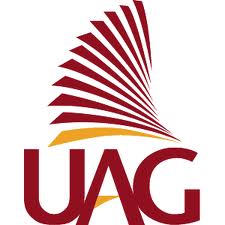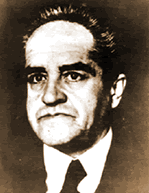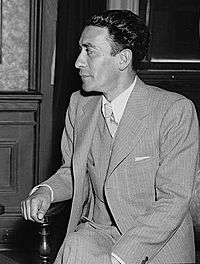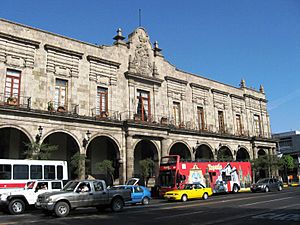Universidad Autónoma de Guadalajara facts for kids
 |
|
| Motto | "Ciencia y Libertad" ("Science and Freedom) |
|---|---|
| Type | Private |
| Established | March 3, 1935 |
| President | Antonio Leaño Reyes |
| Students | 16,000 |
| Address |
Av. Patria 1201
,
,
Col. Lomas del Valle 3ª Seccion, C.P. 45129 Mexico
20°41′37″N 103°24′59″W / 20.6937°N 103.4163°W |
| Campus | Urban, 2,000 acres (810 ha), distributed in 4 campuses |
| Newspaper | Nexo Universitario, Alma Mater |
| Colors | |
| Nickname | Tecos |
|
Sporting affiliations
|
CONCACAF Division 1A, 7 varsity teams |
| Mascot | Owl |
The Universidad Autónoma de Guadalajara (UAG), also known as the Autonomous University of Guadalajara, is a private university in Guadalajara, Mexico. It was founded in 1935. UAG was the very first private university and medical school in Mexico.
The university was created because some people wanted a different kind of higher education. At that time, public universities in Mexico were moving in a new direction. UAG was first called the University of the West. Later, its name changed to Universidad Autónoma de Guadalajara.
UAG also started the first community college in Mexico, called University in the Community (UNICO). The university runs elementary schools, middle schools, and high schools too. It offers many different study programs, including advanced degrees. UAG is now one of the most important schools in Latin America. Students from over 25 countries come to study here.
Contents
How UAG Started: A Look Back
Why Was UAG Created?
After the Mexican Revolution (1910–1920), the government wanted to make big changes. These changes aimed to improve the country based on the revolution's ideas. In 1934, a leader named Plutarco Elias Calles gave a speech. He said that schools should teach young people new ideas. He believed that education should be free from old influences.
Mexico's Constitution had rules about education. It said that public schools should not be linked to religion. In 1934, the Constitution was changed. It said that public schools should teach a "socialist education." This meant focusing on social equality and community.
Different Ideas for Universities
Around 1933, there were different ideas about how universities should be run. At the National University, some people wanted a more traditional approach. They believed in "academic freedom." This meant professors and students should be free to explore ideas without strict rules. Others wanted the university to follow a specific social and economic teaching.
These different ideas caused disagreements. In 1933, universities decided to adopt the new social teaching. When this idea came to the University of Guadalajara, some students protested. This led to problems, and the public university was closed for a short time.
The public university reopened in 1935. To solve the conflict, the governor of Jalisco allowed a new private university to be created. This was the University of the West, which later became UAG.
First Steps and Classes
The first building for UAG was Nuñez building 28. The founders worked hard to get the university ready. They rented buildings for schools, planned what students would learn, and hired teachers. They also made sure that UAG's studies would be recognized by the National Autonomous University of Mexico (UNAM).
The first leader of UAG was Agustin Navarro Flores. Under his guidance, the first schools were set up. On May 5, 1935, the School of Law got its first director. On May 15, the School of Medicine got its first directors. Soon after, schools for Dentistry, Engineering, and a High School were also started.
Later, in 1956, the university began building its main campus, called University City. This campus opened in 1970. It included a large library and other important buildings.
Gaining Full Independence
In 1991, the Mexican government gave UAG full academic independence. This meant the university could create its own study programs and award degrees. This was a big step for UAG.
UAG also worked with many other schools around the world. It became a leader in international education groups. In 1987, the head of UAG was even chosen to lead a big international group of university presidents.
Innovation and Learning
Helping Teachers Grow
UAG has a special program called "Strengthening Teachers." This program helps professors improve their teaching skills. Experts from other countries visit UAG to share their knowledge. UAG teachers also get to visit other universities around the world to learn new things.
Continuing Education for Everyone
The Division of Continuing Education at UAG offers many courses for adults. It started in 1972. These courses help people learn new skills or improve existing ones. They cover many different topics, from technology to business.
Medical School at UAG
UAG has the oldest private medical school in Mexico. The first medical class was held on June 5, 1935. The first hospital linked to the university was named Hospital Ramón Garibay.
In 1963, the basic science classes for medical students moved to the Lomas del Valle campus. This campus has the Institute of Biological Sciences. Later, in 1974, a second university hospital opened. It was named after Doctor Ángel Leaño, one of the university's founders. This hospital was designed to help students learn in a practical way.
Since 1970, these hospitals have offered special training programs for doctors. These programs include training in areas like pediatrics (children's health), gynecology (women's health), and anesthesiology (pain relief during surgery). Today, the Medical School offers training in many more areas, like eye care (ophthalmology) and brain surgery (neurosurgery).
More than 15,000 doctors who graduated from UAG's Medical School now work in all 50 states of the U.S. and in over 15 other countries. The school works with more than 100 hospitals in Mexico and many others worldwide.
Helping Communities with Medicine
Since 1955, UAG has had a program to help poor communities. Students and professors from different fields, like medicine, dentistry, and nursing, work together. They provide health care and support to people in need.
In 1973, this became a formal program called Medicine in the Community (PMC). It helps with medical brigades and mobile hospitals during disasters. In 1998, the Primary Care Mobile Unit (UMAP) was created. This unit helps bring basic health services to communities. It gives medical students a chance to practice helping people who are sick or in need.
Important Approvals and Recognition
UAG's Medical School is recognized by many important organizations around the world. It is listed in the World Health Organization's directory of medical schools. The United States Department of Education also approves it. This means that a UAG medical degree is widely accepted.
UAG is one of the top international medical schools. Many of its graduates become licensed doctors in the United States of America.
School of Journalism and Communication
In 1970, UAG started its School of Journalism. Later, it grew into the School of Communication Sciences. Students began publishing their own newspaper, Eight Columns. This newspaper became a daily publication in 1978, reaching many people in Jalisco.
The university also publishes other newspapers and magazines. These include the Nexus newspaper and the Alma Mater magazine, which is for university graduates. There is also an academic publication called Teaching, which is read in Latin America. The university's own press publishes many books each year for education and research.
UNICO: University in the Community
University in the Community (UNICO) joined UAG in 1992. It was inspired by community colleges in the United States. UNICO offers shorter courses that help students get a professional certificate. These certificates are officially recognized throughout Mexico.
UAG's Sports Stadium
The university's sports teams, including the Tecos F.C. soccer team, play their home games at the Estadio Tres de Marzo. This stadium is located in Zapopan, Jalisco. It can hold over 30,000 people.
The stadium has been improved many times over the years. When UAG's soccer team moved up to higher leagues, the stadium was made bigger to meet the rules. It was also renovated for the 1986 World Cup. The stadium is named "Estadio Tres de Marzo" (March 3rd Stadium) because UAG was founded on March 3, 1935.
Sports at UAG
Soccer Team: The Tecos
The university's professional soccer team is called Tecos. The name "Tecos" comes from the university's symbol, the Tecolote. This is a Spanish word for "owl". The team plays at the Estadio Tres de Marzo.
The university had an amateur soccer team since 1935. In 1971, they joined the professional Mexican Football Federation. They quickly moved up through the leagues. In the 1974–1975 season, they reached the top division of Mexican soccer.
The Tecos have won the national championship once. They are the only team in Mexican soccer history to start in the lower divisions and then win the championship. In 2009, the team's name changed to Estudiantes.
Famous People Who Studied at UAG
- Sofía Aragón - Mexicana Universal 2019 (a beauty pageant winner)
- Rande Lazar - a doctor who specializes in ear, nose, and throat issues for children.
- Durell Peaden MD - an American politician and former Senator for Florida.
- Lloyd Richardson - a former President of the Parliament of Sint Maarten.
- Mauricio Toussaint - an artist.
See also
 In Spanish: Universidad Autónoma de Guadalajara para niños
In Spanish: Universidad Autónoma de Guadalajara para niños
- Los TECOS






